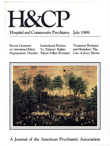Predicting Discharge and Follow-up Status of Hospitalized Adolescents
Abstract
The functioning of 58 adolescent psychiatric patients at hospital admission , discharge, and one-and-a-half-year follow-up was examined in relation to six predictor variables: level of precipitating stress, primary process thinking on the Rorschach test, cognitive inefficiency, severity of psychopathology , maladaptive behavior on the unit, and process versus reactive illness. Severity of psychopathology and cognitive inefficiency were significantly related to the adolescents' functioning at all three observation points. High precipitating stress and short duration of symptoms (that is, in reactive illnesses) were associated with significantly better functioning at follow-up. Primary process thinking on the Ronschach was correlated with severe disturbances on admission, but was unrelated to outcome at discharge or follow-up. Maladaptive behavior on the unit was unrelated to functioning at any time. The authors concluded that outcome for hospitalized adolescents is determined by key patient differences and is systematically predictable.
Access content
To read the fulltext, please use one of the options below to sign in or purchase access.- Personal login
- Institutional Login
- Sign in via OpenAthens
- Register for access
-
Please login/register if you wish to pair your device and check access availability.
Not a subscriber?
PsychiatryOnline subscription options offer access to the DSM-5 library, books, journals, CME, and patient resources. This all-in-one virtual library provides psychiatrists and mental health professionals with key resources for diagnosis, treatment, research, and professional development.
Need more help? PsychiatryOnline Customer Service may be reached by emailing [email protected] or by calling 800-368-5777 (in the U.S.) or 703-907-7322 (outside the U.S.).



